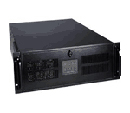Rackmount Systems
Consider the facts below to help you determine the Rackmount Chassis that’s
right for your project
Your Rackmount Dimensions
All standard rackmount chassis come in a width of 19-inchs. Rightfully, this is
an industry standard width that today's rackmount computing systems abide by. However,
the height dimension, or the number of vertical spaces it occupies in the rack itself,
dictates the chassis’ scalability to your application.
Units come in “U”s, with each “U” equaling 1.75 inches of vertical space in a rack
system. Advantech offers solutions from 1U to 7U rackmount systems.
|

|

|

|
|
1U Rackmount
|
2U Rackmount
|
4U Rackmount
|
Will You Require 1U, 4U or 7U?
Naturally, your application will determine how many units your industrial
rackmount solution requires. Here are some examples:
- Requirements for a system with two to a maximum of four full-sized
PCI or PCIe slots can usually be met with a motherboard system in a 2U chassis.
- If you have requirements such as a dual backplane chassis with two
full-sized single board computer boards and peripheral cards, they plug in perpendicular
to your backplane, requiring more vertical space. Therefore, you require least a
4U rackmount chassis to accommodate needs for multiple cards. (See our Backplane
Selection Guide for more information on choosing backplane architecture.)
- If you are in need of a rackmount system utilizing RAID 5 or RAID 10
- requiring at least three hard drives - then you need at least a 2U chassis in
order to house them.
- If you plan on your chassis housing a motherboard computer design and
less than four peripheral cards, a
riser card can enable a “butterfly” backplane arrangement
accommodating three cards. This way, you can often keep the form factor down to
the 1U size.
Another good rule-of-thumb is that if you plan on using PCI peripheral board slot
space in your motherboard, it is best to shop for a 2U system or more. In a system
with backplane architecture featuring more expansion, the answer is usually found
in a 4U system. If you would like to talk to a sales engineer about your exact requirement,
contact one here.
Slot selections
Card size and the type of bus/expansion (ISA, PCI, PCIe) are the
most frequent factors in determining slot selection requirements for your rackmount
solution. It is common that single backplanes featuring several slots -- 7 to 14
slots, for example -- take significant space going depthwise. Thus, if you require
a rackmount solution containing nine full-sized peripheral boards, you will need
a 20-slot rackmount chassis to accommodate them.
When a rackmount solution requires a
PICMG 1.3 backplane with a combination of PCI and PCIe slots (especially
9 to 14 slots), rackmount chassis extend deeper to provide room for the extra slots.
Therefore, your rack depth space requirements must be taken into consideration.
|
|

|
|
Depth of a 20-slot rackmount chassis
|
Single or Redundant Power Supply?
Power supply is a factor in your rackmount solution that should not
be overlooked when ordering. Many higher-end mission critical servers and network
equipment incorporate a Redundant Power Supply (RPS), so that if the main
power supply were to fail, the rack would have a backup or fail-safe to fall back
on, so as to eliminate downtime. A common data center design uses a minimum of two
sets of independent circuits within each rack.
|

|

|
|
Standard Power
Supply (PS)
|
Redundant Power
Supply (RPS)
|
Ideally, both sets of circuits should come from different power sources
capable of independently handling the entire anticipated load capacity of the rack.
If it sounds like it’s time for you to consider your application “mission critical”,
then you should include a redundant power supply in your configuration.
Heat Dissipation
Let’s face it, things are going to start getting a little warm as
you add computing power into your rackmount solution, and heat is the enemy of electronics.
Some considerations to take into account:
- Due to the greater volume inside the casing walls, chassis greater
than 1U dissipate heat well.
- A design that requires more than four CPUs will often require a casing
with added flow, or more than one chassis fan, so plan your unit requirements to
accommodate this.
- A rackmount application requiring 24/7 or similar runtime usage may
require more than one chassis fan for extra heat dissipation.
- If your rackmount chassis contains multiple CPUs and you are concerned
with overheating, positioning the rackmount system where the spaces above it and
below it are unoccupied may provide the required heat dissipation.
<< back to Selection Guide

